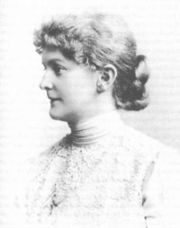
Marie Steiner-von Sivers
Encyclopedia

Rudolf Steiner
Rudolf Joseph Lorenz Steiner was an Austrian philosopher, social reformer, architect, and esotericist. He gained initial recognition as a literary critic and cultural philosopher...
and one of his closest colleagues. She made a great contribution to the development of anthroposophy
Anthroposophy
Anthroposophy, a philosophy founded by Rudolf Steiner, postulates the existence of an objective, intellectually comprehensible spiritual world accessible to direct experience through inner development...
, particularly in her work on the renewal of the performing arts (eurythmy
Eurythmy
Eurythmy is an expressive movement art originated by Rudolf Steiner in conjunction with Marie von Sivers in the early 20th century. Primarily a performance art, it is also used in education — especially in Waldorf schools - and as a movement therapy....
, speech and drama), and the editing and publishing of Rudolf Steiner's literary estate.
Life and work
Marie von Sivers was born of an aristocratic family in Włocławek, PolandPoland
Poland , officially the Republic of Poland , is a country in Central Europe bordered by Germany to the west; the Czech Republic and Slovakia to the south; Ukraine, Belarus and Lithuania to the east; and the Baltic Sea and Kaliningrad Oblast, a Russian exclave, to the north...
, then part of Russia
Russia
Russia or , officially known as both Russia and the Russian Federation , is a country in northern Eurasia. It is a federal semi-presidential republic, comprising 83 federal subjects...
. She was well-educated and was fluent in Russian, German, English, French and Italian. She studied theater and recitation with several teachers in Europe.
Relationship to Rudolf Steiner
Marie von Sivers "appeared one day" at one of Rudolf SteinerRudolf Steiner
Rudolf Joseph Lorenz Steiner was an Austrian philosopher, social reformer, architect, and esotericist. He gained initial recognition as a literary critic and cultural philosopher...
's early lectures in 1900. In the autumn of 1901, she posed the question to Steiner, "Would it be possible to create a spiritual movement based on European tradition and the impetus of Christ?" Rudolf Steiner later reported:
With this, I was given the opportunity to act in a way that I had only previously imagined. The question had been put to me, and now, according to spiritual laws, I could begin to answer it.
Marie von Sivers collaborated with Steiner for the rest of Steiner's life and carried his work beyond his death in 1925 until her own death in 1948. She accompanied him and helped him as secretary, translator, editor, and organizer of his lecture tours and other public activities. She assisted Steiner's work with her own resources and in 1908 founded the Philosophical-Theosophical Press (later Philosophical-Anthroposophical) to publish Steiner's work.
On December 24, 1914, Marie von Sivers married Rudolf Steiner. Anna Eunicke Steiner, Steiner's first wife, had died in 1911. From 1914, Steiner drew up a succession of wills naming Marie Steiner-von Sivers as heir to his entire work and property and his successor in the leadership of the anthroposophical movement.
Eurythmy and speech formation
Starting in 1912, the art of eurythmyEurythmy
Eurythmy is an expressive movement art originated by Rudolf Steiner in conjunction with Marie von Sivers in the early 20th century. Primarily a performance art, it is also used in education — especially in Waldorf schools - and as a movement therapy....
was developed by Rudolf Steiner. Under Marie Steiner-von Sivers' guidance, it developed in three directions, as a stage art, as an integral part of Waldorf pedagogy, and as a therapeutic method. Under her tutelage, two schools of eurythmy were founded, in Berlin
Berlin
Berlin is the capital city of Germany and is one of the 16 states of Germany. With a population of 3.45 million people, Berlin is Germany's largest city. It is the second most populous city proper and the seventh most populous urban area in the European Union...
and in Dornach
Dornach
Dornach is a municipality in the district of Dorneck in the canton of Solothurn in Switzerland.-History:Dornach is first mentioned in 1223 as de Tornacho. In 1307 it was mentioned as zu Dornach...
, Switzerland
Switzerland
Switzerland name of one of the Swiss cantons. ; ; ; or ), in its full name the Swiss Confederation , is a federal republic consisting of 26 cantons, with Bern as the seat of the federal authorities. The country is situated in Western Europe,Or Central Europe depending on the definition....
.
Marie von Sivers was trained in recitation
Recitation
A recitation is a presentation made by a student to demonstrate knowledge of a subject or to provide instruction to others. In some academic institutions the term is used for a presentation by a teaching assistant or instructor, under the guidance of a senior faculty member, that supplements...
and elocution
Elocution
Elocution is the study of formal speaking in pronunciation, grammar, style, and tone.-History:In Western classical rhetoric, elocution was one of the five core disciplines of pronunciation, which was the art of delivering speeches. Orators were trained not only on proper diction, but on the proper...
and made a study of purely artistic speaking. She gave introductory poetry recitals at Steiner's lectures and assisted him in the development of the four Mystery Dramas (1910-1913). With her help, Steiner conducted several speech and drama courses with the aim of raising these forms to the level of true art.
Biographical resources
- Marie Savitch, Marie Steiner-von Sivers: Fellow worker with Rudolf Steiner, London: Rudolf Steiner Press, 1967. ISBN 0-85440-057-5.
- Hans Peter van Manen, Marie Steiner: Her place in world karma, London: Temple Lodge, 1995. ISBN 0-90469-376-7.
- Wilfried Hammacher, Marie Steiner: Lebensspuren einer Individualität, Stuttgart: Verlag Freies Geistesleben, 1998 (German). ISBN 3-77251-798-6.
External links
- Biographical sketch and photographs (German)
- Biography (German)
- History of the Rudolf Steiner Nachlassverwaltung (German)

